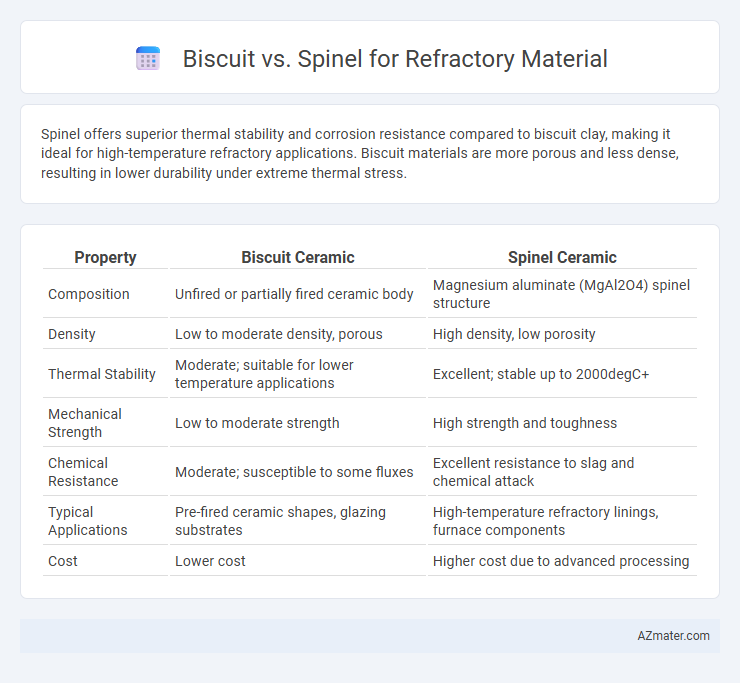Spinel offers superior thermal stability and corrosion resistance compared to biscuit clay, making it ideal for high-temperature refractory applications. Biscuit materials are more porous and less dense, resulting in lower durability under extreme thermal stress.
Table of Comparison
| Property | Biscuit Ceramic | Spinel Ceramic |
|---|---|---|
| Composition | Unfired or partially fired ceramic body | Magnesium aluminate (MgAl2O4) spinel structure |
| Density | Low to moderate density, porous | High density, low porosity |
| Thermal Stability | Moderate; suitable for lower temperature applications | Excellent; stable up to 2000degC+ |
| Mechanical Strength | Low to moderate strength | High strength and toughness |
| Chemical Resistance | Moderate; susceptible to some fluxes | Excellent resistance to slag and chemical attack |
| Typical Applications | Pre-fired ceramic shapes, glazing substrates | High-temperature refractory linings, furnace components |
| Cost | Lower cost | Higher cost due to advanced processing |
Introduction to Refractory Materials
Refractory materials, essential for high-temperature industrial processes, must exhibit exceptional thermal stability, mechanical strength, and chemical resistance. Biscuit and spinel are two prominent refractory materials, with biscuit often used for its porosity and ease of shaping, while spinel, a magnesium-aluminum oxide, offers superior slag resistance and durability. Understanding their distinct thermal properties and applications helps optimize furnace linings and improve operational efficiency in industries like steelmaking and ceramics.
Overview of Biscuit in Refractories
Biscuit in refractories refers to a partially fired shaped refractory material that retains some porosity and mechanical strength, facilitating easier handling and machining before final firing. This intermediate stage allows for precise dimension control and reduces the risk of deformation during subsequent processing. Biscuit refractories are essential in producing complex shapes with improved structural integrity compared to raw materials.
Spinel: Composition and Properties
Spinel, a refractory material with the chemical formula MgAl2O4, is prized for its exceptional thermal stability and resistance to slag corrosion. Its unique crystalline structure provides high mechanical strength, excellent thermal shock resistance, and low thermal expansion, making it ideal for harsh industrial environments. Compared to biscuit refractory, spinel offers superior durability and chemical inertness, enhancing the lifespan of refractory linings in steelmaking and kiln applications.
Manufacturing Processes of Biscuit and Spinel
Biscuit refractory materials are produced through a process of mixing raw materials like clay, alumina, or silica, followed by shaping via pressing or extrusion and then fired at lower temperatures to achieve partial sintering and hardness. Spinel refractory manufacturing involves blending magnesium oxide and aluminum oxide powders, which are then calcined at high temperatures often exceeding 1600degC to form the spinel phase, followed by sintering or hot pressing to enhance density and mechanical strength. The biscuit process results in a porous intermediate product suited for further processing, whereas spinel's manufacturing emphasizes high-temperature solid-state reactions to develop a stable, corrosion-resistant crystalline structure.
Thermal Resistance Comparison
Biscuit refractory materials exhibit moderate thermal resistance, typically withstanding temperatures up to 1200degC, making them suitable for general high-temperature applications. Spinel refractories, composed primarily of magnesium aluminate, offer superior thermal resistance, enduring temperatures beyond 1750degC with better thermal shock stability and chemical inertness. The enhanced thermal resistance of spinel compared to biscuit ensures longer service life and improved performance in extreme thermal environments such as furnaces and kilns.
Mechanical Strength and Durability
Spinel refractories exhibit superior mechanical strength compared to biscuit refractories due to their dense microstructure and higher resistance to thermal shock, making them ideal for high-stress industrial environments. Biscuit materials, while cost-effective, often demonstrate lower durability and mechanical integrity under prolonged exposure to extreme temperatures and corrosive conditions. Spinel's enhanced performance in maintaining structural stability over time contributes to its preferred use in applications demanding long-term refractory reliability.
Chemical Corrosion Resistance
Spinel exhibits superior chemical corrosion resistance compared to biscuit refractory materials due to its high purity and stable crystal structure, which enhances its durability in aggressive environments. The chemical inertness of spinel allows it to withstand acidic and basic slags, minimizing degradation and extending service life in high-temperature industrial applications. In contrast, biscuit refractories often contain impurities that increase susceptibility to chemical attack, reducing their effectiveness in severe corrosive conditions.
Cost and Availability Analysis
Biscuit refractory materials generally offer lower initial costs compared to spinel due to simpler production processes and more abundant raw materials. Spinel, while more expensive, provides superior thermal stability and chemical resistance, justifying its higher price in high-performance applications. Availability of biscuit refractories tends to be broader globally, whereas spinel is limited to specialized suppliers, impacting lead times and overall project budgeting.
Industrial Applications: Biscuit vs Spinel
Biscuit refractories offer excellent thermal shock resistance and are commonly used in steel-making furnaces and kiln linings due to their durability at high temperatures. Spinel refractories provide superior chemical stability and corrosion resistance, making them ideal for cement production and glass manufacturing environments where slag resistance is critical. Choosing between biscuit and spinel depends on the specific industrial application, temperature demands, and exposure to aggressive chemical environments.
Conclusion: Choosing the Right Refractory Material
Biscuit and spinel refractories offer distinct advantages based on their chemical composition and thermal properties, with biscuit providing better thermal shock resistance and spinel excelling in corrosion resistance and mechanical strength. Selecting the appropriate refractory material depends on specific application requirements, including temperature range, exposure to slags, and mechanical stress. For environments demanding high durability and longevity under extreme conditions, spinel's superior performance often makes it the optimal choice, while biscuit suits applications prioritizing rapid thermal cycling stability.

Infographic: Biscuit vs Spinel for Refractory Material
 azmater.com
azmater.com